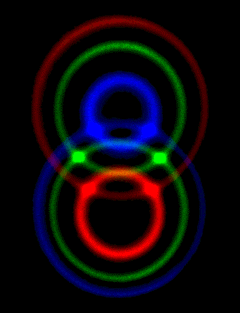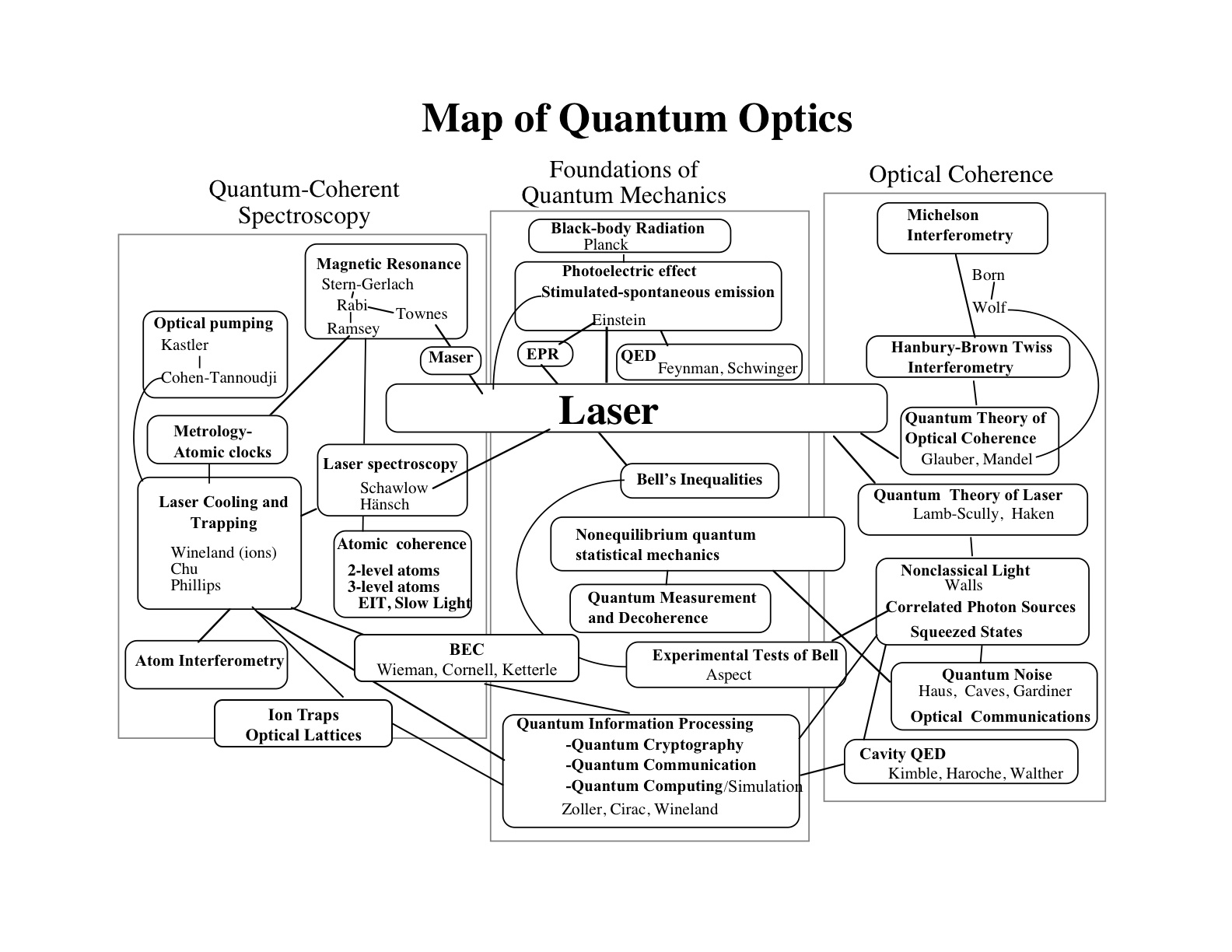

Problem Session: Mondays 11:00-12:00 (Zoom)
TA Problem Session: Wednesdays
11:00-12:00 (room 2500)
Quantum optics is a broad and varied subject that deals with the study, control, and manipulation of quantum coherence associated with electromagnetic fields. This includes the basic interaction of photons and matter and the nonclassical nature of the electromagnetic field itself. Quantum optics is the natural arena for experimental tests of the foundations of quantum mechanics and measurement, especially in the context of open, nonequilibrium quantum systems. The theoretical and experimental tools of quantum optics have helped to ignite the "second quantum revolution" and the development of Quantum Information Science (QIS), with applications in quantum computation and communication.
- Quantum and classical coherence
- Atom-photon coupling and atomic coherence
- The quantum electromagnetic vacuum
- Nonclassical light and photon statistics
- Quantum optical particles and waves (discrete and continuous
variables)
- Foundations of entanglement and quantum maps
- Open quantum systems and decoherence
- Quantum trajectories and continuous measurement
- Fundamental paradigms in quantum optics (cavity QED, ion and
neutral atom traps, entangled light)
- Applications in quantum information science (quantum
communication, computation, metrology)

"Recommended" Texts (none required):
* Atom-Photon interactions- Cohen-Tannoudji,
* Quantum Optics - Scully and Zubairy,
* The Quantum
World of Ultra-Cold Atoms and Light: Book 1: Foundations of
Quantum Optics - Gardiner and Zoller.
* Introduction to Quantum Optics - Grynberg Aspect, and Fabre,
* Exploring the Quantum: Atoms, Cavities, and Photons - Haroche and Raimond.
We will not be following any of these texts directly . They all have strengths in different areas and are good to have on your bookshelf.
Other Standard Texts:
* Quantum Properties or Radiation, R. Loudon• Quantum Optics by Walls and Milburn
* Statistical Methods in Quantum Optics 1 and 2, by H. J. Carmichael* Quantum Noise, by C. Gardiner (also Handbook of Stochastic Methods)
* Introductory Quantum Optics by C. Gerry and P. Knight
Additional
Resources
* Optical Coherence and Quantum Optics, by L. Mandel and E. Wolf
* Optical Resonance and Two-Level Atoms , by Allen and J. H. Eberly* Quantum Statistical Properties of Radiation, by W. H. Louisell
Grading:
* Problem Sets (10 assignments) 80%
* Final Project 20%
*
Problem sets will be available on the web, about every week.
Generally assignments will be due Tuesdays, 5:00pm, in the
TA's maiilbox.
Phys. 566: Quantum Optics I
I. Classical foundations
A. Oscillators, interference, and coherence.
B. Lorentz oscillator model.
II. Quantum foundations
A. Density matrix and coherence.
B. Two level systems -- Qubits, Pauli algebra, Bloch-sphere,
magnetic resonance.
C. Quantum simple harmonic oscillator.
III. Optical resonance for two level atoms
A. Atom-photon interaction in electric dipole approximation.
B. Pseudo-spin formulation, Rabi flopping.
C. Density matrix formulation.
D. Phenomenological damping -- master equation and rate
equations.
IV. The electromagnetic vacuum
A. Quantization of the electromagnetic field.
B. Spontaneous emission and Wigner-Weisskopf theory.
C. Jaynes-Cummings model -- Dressed states,
Cavity QED.
V. Three level quantum coherence
A. Raman resonance.
B. Dark states and EIT.
VI. Quantum-Optical Coherence and Nonclassical Light
A. Photon counting statistics and classical statistical optics
B. Coherent states as quasi-classical states.
C. Glauber's correlation functions.
D. Bunching, antibunching, and photon statistics.
E. Squeezed states if light.
|
Aug. 24 |
Overview of Class. Quantum and Classical Coherence |
|
|
Aug. 26 |
Coherence and the
Density Matrix
|
|
|
Aug. 31 |
Continuation |
|
|
Sep. 2 |
Qubits
-- Paul algebra, Bloch-sphere, SU(2) |
|
| Sep. 7 |
Continuation |
|
|
Sep. 9
|
Magnetic
Resonance - Rabi flopping
|
|
|
Sep. 14 |
Continuation |
|
|
Sep. 16 |
Two-level atoms and Lorentz Oscillator |
|
|
Sep. 21 |
Optical Bloch
Equations
Phenomenological decay T1 and T2 |
|
|
Sep. 23 |
Introduction to the Master
Equation
|
|
|
Sep. 28 |
Two-level atom damped response Laser rate equations |
Lecture #7 |
|
|
Three-level
atoms: Adiabatic elimination
Raman Transitions and Optical Control of Ground
States
|
Lecture #8 |
|
Oct. 5 |
Continuation |
|
|
Oct. 7 |
Dark States, Coherent Population Trapping,
and EIT |
Lecture #9 |
|
Oct. 12 |
Introduction
to Quantum Field Theory
|
Lecture #10 |
Oct. 14 |
Fall Break |
|
Oct.
19
|
Continuation
|
|
|
Oct. 21 |
Quantization of the electromagnetic field | Lecture #11 Lecture #11b |
|
` Oct. 26 |
Quantized Field - Atom Interactions |
|
Oct. 28 |
Jaynes-Cummings model |
|
|
Nov. 2 |
Markov
approximation
|
Lecture #13 |
|
Nov. 4 |
Continuation |
|
|
Nov. 9 |
Are photons
real? Photon counting experiments and photon statistics |
Lecture #14 |
|
Nov. 11
|
Coherent
states as quasiclassical states of the
electromagnetic field
|
|
|
Nov. 16 |
Statistical Optics. |
Lecture #15 |
|
Nov. 18 |
Bose-Einstein statistics
|
|
|
Nov. 23 |
Continuation |
|
Nov. 25 |
Thanksgiving |
|
Nov. 30
|
Glauber-Theory of Photon Counting Photon Optics |
Glauber Les Houches Lectures |
Dec. 2 |
Continuation |
|
Dec. 7 |
|
|
Dec. 9 |
Continuation |
|
Problem Set #1 |
Problem Set #6 |
|
Problem Set #2 |
Problem Set #7 |
|
Problem Set #3 |
Problem Set #8 |
|
Problem Set #4
|
Problem Set #9 |
|
Problem Set #5 |
Problem Set #10 |